Square-tailed Kite
Square-tailed KiteLophoictinia isura | |
|---|---|
| Kingdom: | Animalia |
| Phylum: | Chordata |
| Class: | Aves |
| Order: | Falconiformes |
| Family: | Accipitridae |
| Status | |
| World: | least concern (IUCN Red List) |
| Australia: | not listed (EPBC Act 1999) |
| Victoria: | Vulnerable (FFG Threatened List 2025) |
| FFG: | Listed; no Action Statement |
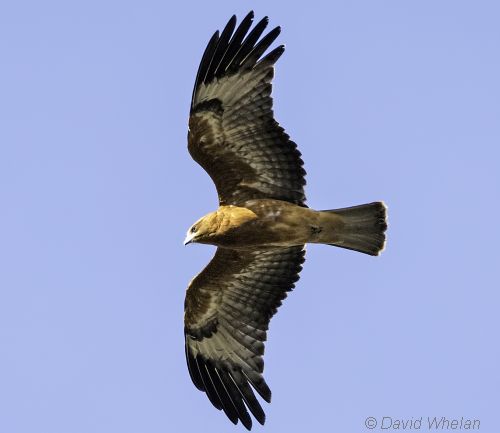
The Square-tailed Kite Lophoictinia isura is a medium sized raptor endemic to mainland Australia. It is a species which can spend many hours on the wing with little active flight and can be observed either soaring high over open country, scrub or woodland or close to tree tops and through the tree canopy.
Identification
The adult Square-tailed Kite ranges from 50-56 cm in height and has a wingspan of 1.3 metres. Adult birds have a reddish-brown appearance, a white face with thick black streaks on the crown and finer streaks elsewhere. The back and upper wing coverts are dark sepia to reddish brown-black, the underbody is predominantly chestnut or rufous with black streaks. Underwings have rufous colour on the underwing coverts with a light patch at the base of long broadly barred flight-feathers. The tail is 23-25cm long and nearly square shaped with four narrow black bars and a broad subterminal black band. The iris is yellow and the feet and ceres are yellow with black talons on feet. Immature birds have a stronger rich rufous colouring and lack the white face and black streaking. The cere is a flesh colour, and the feet are pale yellow to whitish (Brown & Amadon 1968, MacDonald 1973, Pizzey & Knight 1997, Simpson & Day 1999).
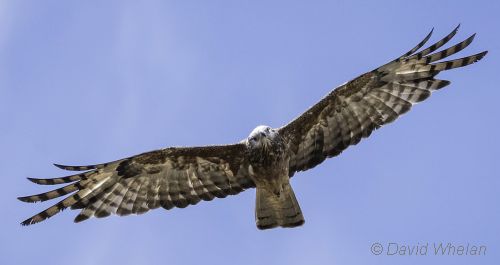
Similar species
The Square-tailed Kite has some similarities in appearance to the Black Kite Milvus migrans, the Black-breasted Buzzard Hamirostra melanosternon and the Red Goshawk Erythrotriorchis radiatus. Distinguishing aspects include:
- the range of Red Goshawk does not include Victoria
- the Square-tailed Kite is smaller in build with a less prominent bill and head than the Black-breasted Buzzard.
- the adult Square-tailed Kite has a distinctly whitish face, long wings and a long square shaped tail.
- the Square-tailed Kite has upswept wings when viewed from straight ahead (Black Kite wings are held flat).
- when perched, the Square-tailed Kite wings extend to or past the length of the tail.
- (for further descriptions refer to: Pizzey 1980, Simpson & Day 1999).
Distribution
The Square-tailed Kite is sparsely distributed throughout the Australian mainland, primarily within 250km of the coast and generally absent from treeless inland areas and from dense forests. The Victorian population is estimated at between 20 and 50 pairs, though it is seen more frequently in western Victoria in recent years (Garnett & Crowley 2000).
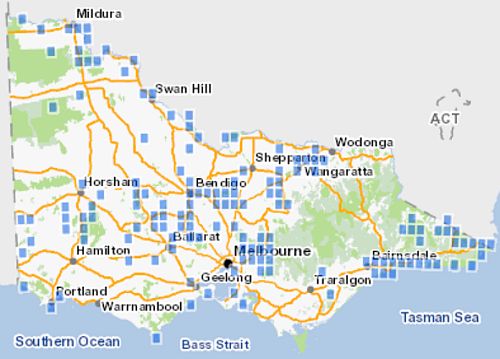
In Victoria, most records are in the Orbost and Mallacoota areas of East Gippsland. Other clusters of records are in the Goldfields area of Central Victoria, particularly in the Bendigo area. There are also multiple records in the Horsham area, Mildura area and Chiltern in north-east Victoria.
Key local government Areas in Victoria
In order of known records. Source: ALA 2017
- East Gippsland Shire
- Greater Bendigo City
- Horsham Rural City
- Indigo Shire
- Hepburn Shire
- Central Goldfields Shire
- Mildura Rural City
- Northern Grampians Shire
- Mount Alexander Shire
- Yarra Ranges Shire
- Ararat Rural City
- Strathbogie Shire
- Mitchell Shire
Ecology & Habitat
The Square-tailed Kite prefers open eucalypt forest and woodlands with mature trees.
Feeding
The Square-tailed Kite is a specialist hunter of passerines, especially honeyeaters and insects in the tree canopy, picking most prey items from the outer foliage by skimming and circling just above or below the tree tops. It also feeds on reptiles, bird eggs and occasionally poultry, but not carrion (Brown & Amadon 1968, Emison et al 1987).
Movement
Some migration is thought to occur between pairs breeding in areas at the southern extent of their range to more northern latitudes for winter, possibly following populations of small passerines on their annual exodus from their breeding areas (Olsen et al 1993, SAC 1998).
Breeding
The Square-tailed Kite breeds once a year in pairs which are thought to bonded for life. The breeding season extends from August to December with most laying occurring from September to November. Outside of the breeding season most observations are of a single bird.
Nesting
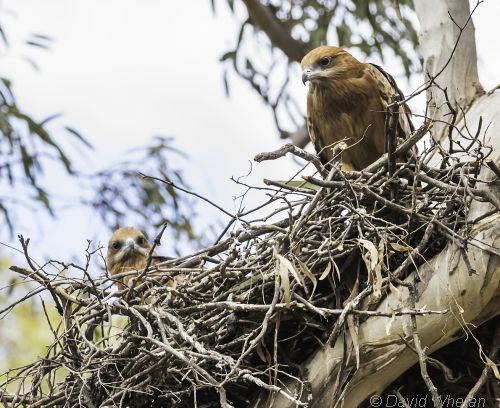
Nests are usually located along or near watercourses and consist of large structures located about 12 –24 metres up on horizontal forks and branches of tall trees over tree canopies. Nests are large stick structures lined with green leaves and strips of bark, they are about 1 metre across and 60 cm deep, with a cup in the centre about 36 cm across and 7 cm deep. The nest is normally built by the birds themselves, but it is sometimes placed on an old nest of another bird. The Square-tailed Kite is also known to use old nests of other raptors (Brown & Amadon 1968, MacDonald 1973, Emison et al. 1987).
Usually two eggs, sometimes three are layed which are incubated from 37 to 42 days. The female does most of the incubating and the male does most of the hunting. The nestling period is a further nine weeks after hatching and usually only one young is reared which is dependent upon being fed from its parents for more than a month after fledging (Brown & Amadon 1968, Olsen et al. 1993).
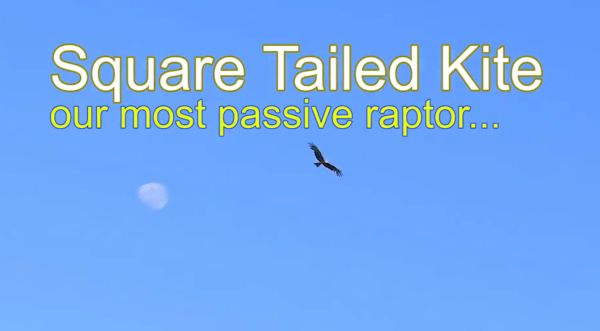
Threats
The Square-tailed Kite is listed as vulnerable in Victoria because it is significantly prone to future threats which are likely to result in extinction, and it is very rare in terms of abundance and distribution with perhaps only 50 pairs in Victoria. The main threat is from activities which have the capacity to destroy or degrade its preferred habitat, such as excessive logging, clearing of native vegetation and altered fire regimes in the Victorian landscape (SAC 1998).
At least half the area of open eucalypt forest and woodland in Victoria has been cleared for agriculture which has resulted in a population decline, particularly in the south of its range. Land use practices such as forestry and pastoralism may deplete its food supply in remaining habitat (Garnett 1992). Other threats include loss of suitable nesting trees, egg collecting and deliberate shooting.
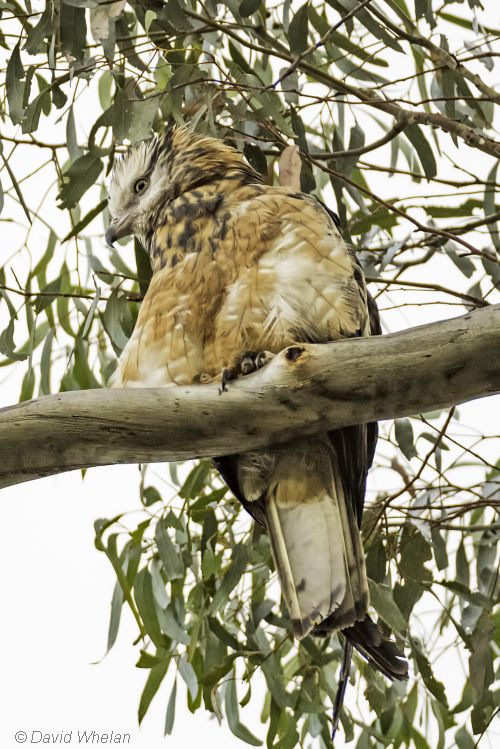
Conservation & Management
The conservation status of Square-tailed Kite was re-assessed from Vulnerable in 2013 (DSE 2013) to Critically Endangered in 2020 as part of the Conservation Status Assessment Project – Victoria (DELWP 2020) but revised back to Vulnerable in Victoria (FFG Threatened List 2025)
Research & Survey – documenting basic life history data on breeding, foraging range, biology and ecology, particularly in Victoria (Garnett & Crowley 2000). Develop methods of assessing population trends.
Habitat protection – ensure that the habitat requirements of the Square-tailed Kite are taken into account with the management of Public Land in regard to prescribed burning and designate special protection zones depending upon the presence of nests. Encourage habitat protection on private land.
Enforcement - implement a special enforcement effort to protect known nets and reduce the threat of egg collection.
Increased appreciation – raising the profile of this species, particularly within in areas where it has been recorded. Consult with landholders, Landcare groups and managers of public land such as Parks Victoria and Department of Environment, Land, Water & Planning regarding the protection of nest sites or potential nest sites.
Habitat restoration & enhancement – inclusion of the Square-tailed Kite in Landscape planning, Catchment Planning, Biodiversity Action Plans and Park Management Plans where appropriate, together with encouraging habitat and dietary components back into the landscape.
References & Links
ALA (2017) Atlas of Living Australia.
Brown L. & Amadon D. (1968) Eagles, Hawks and Falcons of the World. Vol.1 Country Life Books, The Hamlyn Publishing Group Ltd.
DELWP (2020) Provisional re-assessments of taxa as part of the Conservation Status Assessment Project – Victoria 2020, Department of Environment Land Water and Planning, Victoria. Conservation Status Assessment Project – Victoria
DSE (2013) Advisory list of threatened vertebrate fauna in Victoria, Department of Environment, Land, Water & Planning (formerly Department of Sustainability & Environment), Victoria.
Emison W.B., Beardsell C.M., Norman F.I. and Loyn R.H. (1987) Atlas of Victorian Birds. Department of Conservation Forests & Lands and the Royal Australian Ornithologists, Australia.
Garnett S.T. (1992) Threatened and extinct birds of Australia. Royal Australian Ornithologists Union, Report No. 82, Melbourne, Australia.
Garnett S.T. and Crowley G.M. (2000) The Action Plan for Australian Birds 2000, Stephen T. Garnett - Queensland Parks and Wildlife Service, and Gabriel M. Crowley - Birds Australia, Environment Australia, 2000
MacDonald J.D. (1973) Birds of Australia. A.H. & A.W. Reed Pty Ltd.
Olsen P., Crome F., and Olsen J. (1993) Birds of Prey and Ground Birds of Australia. Harper Collins Publishers.
SAC (1998) Final Recommendation on a nomination for listing: Square-tailed Kite Lophoictinia isura, Scientific Advisory Committee, Flora and Fauna Guarantee. Department of Sustainability & Environment:Melbourne.
Simpson, K. & Day, N. (1996) Field Guide to the birds of Australia, Simpson & Day, sixth edition, Penguin Books Australia Ltd.
VBA (2017) Victorian Biodiversity Atlas, Department of Environment, Land, Water & Planning, Victoria. Accessed 16/6/2017.
More Information
Report on Square-tailed Kite in East Gippsland February 2010 pdf
Natural Newstead - observations of Square-tailed Kite in Central Victoria – Geoff Park.
Please contribute information regarding Square-tailed Kite in Victoria - observations, images or projects. Contact SWIFFT

